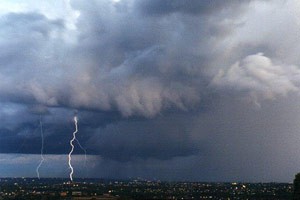Night Time Lightning Photography
- Set your camera on a tripod.
- Connect a cable shutter release or set the remote for taking the shots.
- Lock focus at infinity.
- Set the shutter speed to bulb 'B' (the shutter will stay open for as long as you hold it open). If you don't have this option, set the exposure time to the longest possible - realistically you need 10 to 30 seconds
- Set the aperture (F-stop) to between F2.8 and F5.6. Experiment a little with different settings but I recommend nothing higher than F8 unless you want many bolts of lightning to occur in the one photo.
- Frame the picture where the most lightning is occurring, or where the most spectacular clouds are.
- Observe the lightning for a short while before taking a picture. You will notice that some cloud to ground (CG) lightning strikes very fast (in a fraction of a second it has flashed and gone). Other CG bolts strobe or pulse for anything up to 2 seconds. Sheet lightning (anvil crawlers) sometimes lasts up to a second or more as it spreads across the sky. If the storm is close to you and/or you can see it growing or moving, then exposure times should be at most 15 seconds, or else the cloud will blur (especially if more than one lightning bolt occurs during the exposure). If the storm is a fair way away, you are only framing the storm base, or you cannot see it developing or moving, then exposures can be anything you like! I recommend between 20 seconds and 2 minutes. You can have longer exposure times for higher F stops.
-
For the 'fast' lightning:
- Press the cable/remote to open the shutter.
- Wait for the lightning (or multiple lightning) to occur within the frame of your shot.
- Release the shutter.
-
For the longer lasting lightning:
- You can do the same as above, or
- Wait for the lightning to occur.
- Press the cable/remote to open the shutter as soon as you see the flash.
- Release the shutter after a number of seconds (up to you).

Late Afternoon or Early Morning (low daylight) Lightning Photography
- Set your camera on a tripod.
- Connect a cable shutter release or set the remote for taking the shots.
- Set focus to infinity.
- Set the shutter speed to 'B' if you want to control the length of the exposure, otherwise I recommend setting the speed to aperture priority setting if you have this.
- Set the aperture (F-stop) higher (experiment with F5.6 - F16) than for night shots - it will give you more exposure time, and more chance of capturing the lightning.
- Frame the picture where the most lightning is occurring, or where the most spectacular clouds are.
- Either wait for the lightning to occur then press the cable/remote to open the shutter, or press the cable/remote and hope that lighting occurs reasonably quickly.
- If you have set the speed to automatic then that's it, otherwise, release the shutter after your estimated exposure time.

Day Time Lightning Photography
There isn't much to tell you here, you have to react quickly and be pointing the camera in the right direction. Observe the lightning before you attempt any shots - if all the bolts are very fast and do not strobe, then you will not be able to react fast enough.
- Use a normal landscape dial setting, or set the aperture and the exposure time to what you prefer, as you would with any other day time photograph.
- Lock focus at infinity - you do not want the camera searching for focus before actually taking the picture
- Aim.
- Wait for the lightning!! If you react quickly enough when you see the bolt, you may capture it.
One More Option
There is another technique you can try for lightning photography. If your camera has a fast continuous shooting mode - you can always just do a continuous shoot and hope that lightning occurs during that time. It does require a lot of discarding of images afterwards, but you may be rewarded with a fully branched daytime CG lightning picture!
Credit to :http://www.lightningphotography.com
Source: http://www.lightningphotography.com/tips.html




.gif)
.gif)







0 Responses So Far: